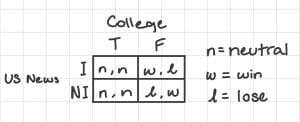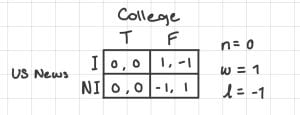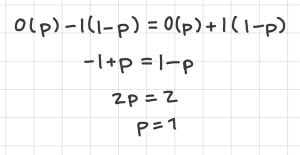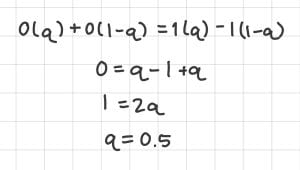College Rankings Through the Lens of Game Theory
Those who are familiar with the cutthroat nature of college admissions in the US know all too well of the vital role the annual US News rankings play in the grand scheme of things. Every college in the country knows the value of a high ranking: more applicants, higher prestige, better funding, and more. In fact, for many institutions, the benefits are so great that a few are even willing to fudge their data in order to climb higher on the never-ending ladder of college rankings. For example, a former dean of Temple University’s business school was found guilty of using fraudulent data just last year. Earlier this year, USC withdrew its education school from the rankings after inaccuracies were found in their data that dated back five years. Many have criticized the all-encompassing nature of this list, stating that it is a gross oversimplification of a complex system, one that is and should not be so easily prescribed a single number. Regardless, US News continues to maintain a strong hold on universities across the nation, as the majority of colleges would rather continue to participate in the flawed yet seemingly vital system than be ranked lowly, or worse–removed from it altogether
So when news broke just last week about Columbia’s dramatic descent in the rankings following a report from Columbia’s own math professor, Michael Thaddeus, it caused quite a stir in the higher education scene. Though the prospect of colleges submitting incorrect data is not a new one, it was unprecedented for a college of Columbia’s caliber to be accused of such a thing. Many have used this news to weigh in on the pros and cons of relying so heavily on what has proved to be an easily manipulated system. Others have called into question the necessity of such a ranking at all. But I believe it also raises a third question: is providing false data just for a higher spot on the list worth the risk?
To answer this, we can start by setting up a payoff matrix, with the two players being a generic college and US News. The college has two choices in strategies to play: either tell the truth (T) or give false data (F). US News then has the choices of investigating the college (I) and not investigating (NI). Of course, this is an extreme oversimplification of things. In the real world it is impossible for any company to be able to look into and verify the data of every institution in the country. Regardless, for the case of this hypothetical, we will make the assumption that this is possible.
As we can see, the only player who holds a dominant strategy in this game is US News, in which it can choose to investigate 100% of the time. Thus there exists on pure strategy Nash equilibrium, which is the strategy set (I, T) with a payoff of (n, n). To better conceptualize this for us, we can substitute the values n = 0, w = 1, and l = -1. This presents us with a new payoff matrix, as seen below:
With these new values, we can then go ahead and calculate the mixed strategy equilibriums:
As we can see, p = 1, which proves that strategy I is indeed the dominant strategy for US News. Meanwhile, College can play the mixed strategy (True, False) with probability (0.5, 0.5). Ultimately, given that the probability in favor of falsifying data is only 0.5, as well as the pure Nash equilibria that favors telling the truth, we can conclude that falsifying data is a strategy that colleges should avoid as the costs far outweigh the benefits.
Click the picture below for more information on the situation, or copy and paste the link
‘https://www.nytimes.com/2022/09/12/us/columbia-university-us-news-ranking.html?smid=url-share’




